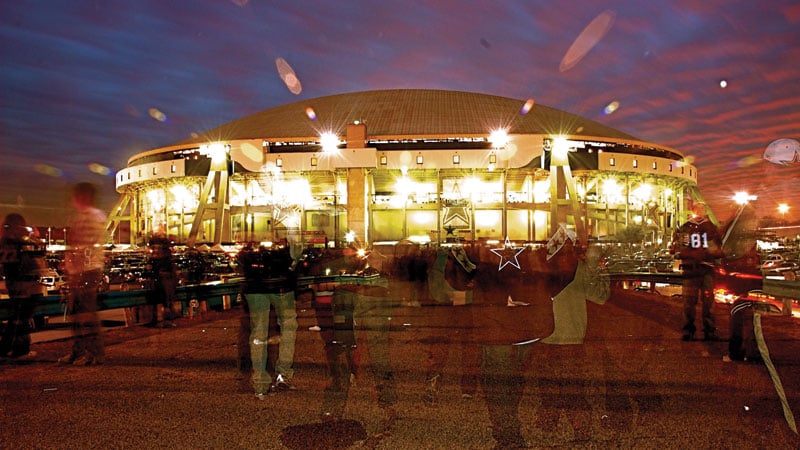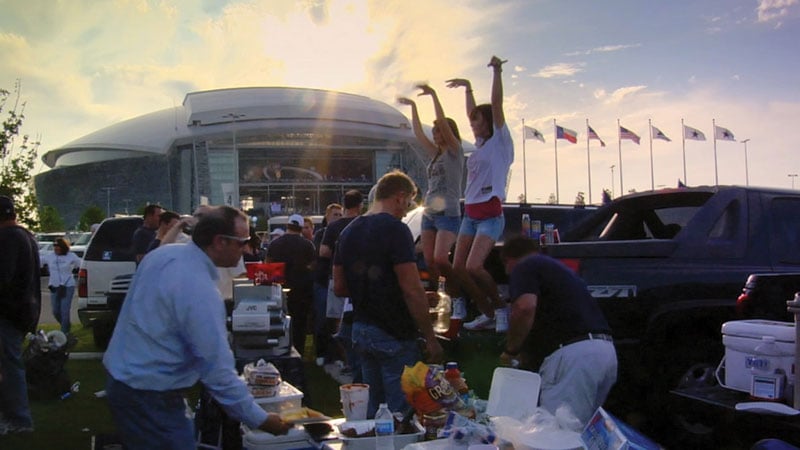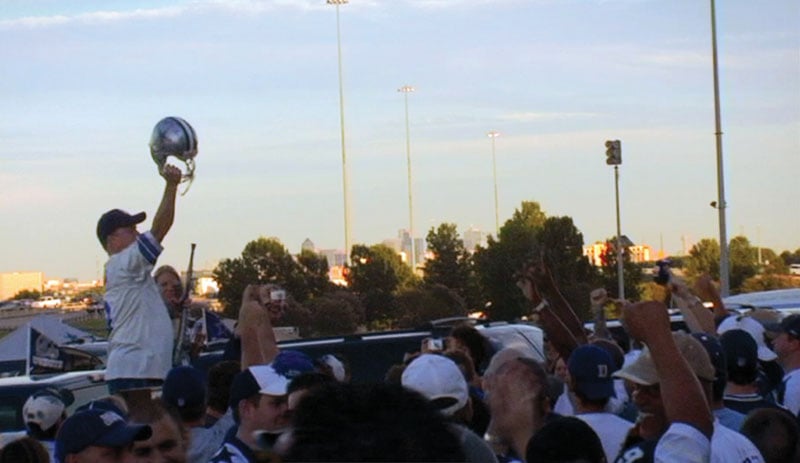
Sky-High Stadium
A version of this story ran in the January 2013 issue.
It’s the evening of Oct. 1 in Arlington and traffic on I-30 has been nightmarish. In addition to the predictably jammed Dallas-Fort Worth rush hour, there’s a marquee matchup scheduled at Cowboys Stadium—Monday Night Football is about to broadcast a live Week 4 showdown between the Cowboys and the Chicago Bears. Both teams are 2-1 going in, and the game has been sold out for months.
That’s more than 86,000 tickets, at prices ranging from an eye-popping $82.83 for upper-level seats overlooking the end zone to a staggering $500 per ticket for premium seats offering a quality 50-yard-line view. If you don’t need to sit, “Party Pass” tickets cost a thrifty $29, plus fees and parking, and allow you to stand on a balcony and watch the game on the enormous high-definition LED displays that hang over the field.
I snagged a spot in the cheap seats: section 406, row 25, one row shy of the top of the stadium, with a face value of $82.83. Multiply that by four—my parents and brother, rabid Bears fans like myself, are in town from Indiana for the game—then add parking ($75 on stadium grounds, though we park at a nearby Arby’s for the bargain-basement price of $40) and concessions ($8.50 for a Miller Lite), and you begin to see what even the most frugal family trip to a Cowboys game can cost.
What we’re really concerned about, though, as we leave the car and make our way to the stadium, is this: We’re decked out in navy and orange and expecting to get heckled by tens of thousands of Cowboys fans.
But that’s not what happens. Plenty of people are sporting Dallas’ trademark blue-and-white, but they’re nearly evenly matched by our Chicago brethren. There are also countless fans dressed as if for a night at the movies. When the Bears score the game’s first touchdown in the second quarter, my cheap-seats section explodes with enthusiasm. All around us, people sing along to “Bear Down, Chicago Bears.”
Chicago will go on to win the game handily, 34-18, and Cowboys fans begin flocking to the exits with well over a quarter to go, hoping to beat the main exodus. At his post-game press conference, someone asks Bears coach Lovie Smith about the crowd. “There’s nothing like hearing the ‘Let’s go Bears’ chant early and throughout the game,” he says. “I thought our fans were outstanding. The Chicago Bears colors were all around. They really were.” Early-bailing Cowboys fans and diehard Bears boosters aside, there are more than a few purely dispassionate spectators in the stadium this night. In a luxury box close to the field, a friend of the family who works as a rep for a major electronics corporation watches the game until the third quarter, when Tony Romo throws his third interception of the night, and his suitemates turn on a television to watch the Rangers game instead.
The suites at Cowboys Stadium cost between $100,000 and $500,000 a year, which means they’re almost exclusively occupied by corporate accounts. Season tickets, which account for the crucial element of any home-crowd fanbase—the same people occupying the same seats week after week, year after year—aren’t much more accessible.
Season tickets throughout Cowboys Stadium—excepting a few nosebleed sections—are sold with a financial instrument called a Personal Seat License (PSL).
The PSL is a one-time fee that customers pay for the right to purchase tickets for a given seat. PSL costs are astronomical: For an even marginally decent seat, fans are looking at PSL costs of close to $12,500, and they go up to $150,000 for quality seats on the 50-yard line. The Cowboys organization will finance it for you, at 8 percent interest, over 27 years.
That fee doesn’t even get you into the stadium—it’s just the price you pay for the right to buy tickets. After spending $29,100 (the average price) for the PSL, the license-holder is required to purchase 10 tickets—one to each of eight regular season games, plus both preseason games—every year for the next 30 years. Those tickets range in cost from $590 annually for upper-level seats over the end zone to $3,400 a year. Failure to follow through with the required purchases can result in revocation of the PSL and forfeiture of all funds already paid toward the license.
In other words, for a family of four to get season tickets to Dallas Cowboys home games, in decent but not spectacular seats in the upper levels over the sidelines, tickets and PSL costs would add up to $5,347.60 a year. For 27 years. Plus parking, which costs $75 a game if purchased from the Cowboys organization. Add the occasional soft pretzel and Miller Lite and you’re easily looking at more than $6,000 to take your family to each season’s eight home games. Over the 30-year life of the PSL commitment, that’s $180,000, over $52,000 more than the average Arlington home price.
All of which casts light on why Cowboys Stadium was packed with so many Bears fans for a Monday Night Football matchup—the blue-collar fans who comprise the lifeblood of a home-field fanbase can’t afford to go. In their place, seats are filled by people who go to a game once just to say they were there, or who were given the tickets as a business perk, or who bought them via Ticket Exchange from someone who purchased a PSL in hopes of making their money back through resales—and who doesn’t care which team the ticket buyer supports, or whether they support a team, or follow football at all. “People want to see the new stadium,” explains Joe Nick Patoski, whose 800-page tome, The Dallas Cowboys: The Outrageous History of the Biggest, Loudest, Most Hated, Best Loved Football Team in America, was released in October by Little, Brown. “They’re not Cowboys fans wanting to root for the Cowboys. Whatever home-field advantage [the team] once had, it’s gone. That’s vanished.”

Home-field advantage is touted in many sports, but it’s especially real in football, where the crowd is commonly referred to as the team’s 12th man. Offensive players need to communicate their plans before the play, and a loud stadium can make that difficult. Before the ball is snapped, every player on the line of scrimmage is required to remain still until the center hikes the ball to the quarterback, which he does after the quarterback counts out the snap; a loud stadium can induce false-start penalties against visiting offenses, putting that team in unmanageable situations. That’s why the Super Bowl is played on a neutral field each year, and why teams compete throughout the season for playoff seeding and the right to host postseason matchups in their home stadium. When opposing coaches like Lovie Smith describe playing in Cowboys Stadium as feeling like a home game, the Cowboys have lost a critical advantage.
The Cowboys aren’t the only NFL team that requires a PSL to buy season tickets—15 other teams require them as well, and every new stadium built is likely to use PSLs to some degree—but they’re certainly the most egregious. By comparison, the Houston Texans’ PSLs, which sold out in 2002, cost anywhere from $600 to $3,900.
The impact on the field is noticeable. In the three complete seasons the Cowboys have played in the new stadium, the team’s record at home is 13-11, and 12-12 on the road. While three seasons is a small sample size, it’s nonetheless true that good NFL teams win at home. The average winning percentage for home teams with winning records since Cowboys Stadium opened is 72.1 percent. The Cowboys win at home only 54.1 percent of the time. During the 10 seasons prior to the team’s move to Arlington, when the Cowboys’ overall record was marginally worse, they still won more than 61 percent of their home games.
Those numbers suggest that the new stadium, with its sky-high ticket prices, prohibitive PSLs and high-tech appeal, is having a negative impact on the team’s success.
“We’re watching the decline of the brand right now,” Patoski says. “The NFL says that the Cowboys are the most popular franchise [in the league]. That’s going to come to an end sooner or later.”
Jerry Jones bought the Dallas Cowboys in 1989 for $140 million, a price that included the old Texas Stadium. Within a few years, the team had become a once-in-a-generation dynasty, winning three Super Bowls in four seasons (1992, 1993 and 1995). Its current estimated value, according to a 2012 report by Forbes, is an astonishing $1.85 billion, the highest valuation in American sports. Jones himself is a polarizing figure, serving as both owner and general manager, and fans frequently question whether he has the football acumen to make day-to-day operational decisions.
Polarizing figure or not, the 1,300 percent increase in the team’s value that Jones has overseen is frequently cited as an example of his off-the-field genius. He’s proudly marketed the Cowboys as America’s Team for a generation, and the iconic star on the team’s helmet carries a cachet that few American sports teams can match.
“It’s a global brand,” Patoski says. “It’s the best-known brand associated with the state of Texas, period. That blue star travels all around the world.”
But the team’s PSLs, and the new stadium that those PSLs keep dedicated fans out of, might, when Jones’ legacy is complete, cast a new wrinkle on his bottom-line brilliance. It’s hard to imagine that an organization that keeps losing can remain as valuable as the Cowboys have been. If Cowboys Stadium cedes its army of die-hard, screaming Cowboys fans that can disrupt opposing teams and give an emotional boost to the home team at key moments, then the Cowboys will suffer.

Cy Ditmore is a lifelong Cowboys fan who hasn’t missed a home game since 1988, and he’s still kicking himself over missing that one. He’s a tailgater who hauls a self-built custom trailer and cooking rig to the stadium four hours before kickoff every week the Cowboys are in town. The rig cost him around $12,000, and he spends as much as $1,000 per game on food, which he cooks and serves free of charge to more than a hundred of his fellow fans on game days.
He’s also a minor movie star. Ditmore—along with fellow tailgater Stan “Tiger” Shults—is the subject of the documentary film America’s Parking Lot, which was released on iTunes and video-on-demand services in November and has screened throughout Texas since its premiere at SXSW in March 2012. In the film, Ditmore explains his decision to purchase a PSL at Cowboys Stadium as he takes the filmmakers on a tour of his Marble Falls property, pointing out where he’d intended to start work on a new house in what he refers to as his “little slice of heaven.”
“My PSL was $12,000” per seat, Ditmore tells the camera. “Could I afford to write them a $24,000 check? By no means. So they offered financing. It’s basically a 30-year note, just like most homes are. You’ve got to make that common-sense, logical decision. Have two seats at [Cowboys] Stadium or pay for your house? That’s a common sense move—the building of my new home has been put off for a while.”
Ditmore pays an annual price of $4,165.12 for his two seats, on top of the $24,000 in PSLs that allow him to buy them. Shults, who opted for lower-cost seats on the sideline upper decks, pays $2,673.80 yearly for the two tickets he and his wife use each season. With only the two seats, Shults and his wife are no longer able to take their kids to every game—not even their daughter Meredith Landry, named after Cowboys icons Don Meredith and Tom Landry.
“I think they see themselves as the end, and I think they might be,” America’s Parking Lot director Jonny Mars says of Shults and Ditmore. “Those guys have that passion because they were able to do it for decades, and they grew up going to games. [Their kids] aren’t necessarily going to talk about getting season tickets right out of high school. Tiger, that was the first thing he bought when he had a job.”
Breaking that generational cycle may be the lasting legacy of Jerry Jones and his PSLs. Squandering home-field advantage by pricing out the type of fans who paint their chests and intimidate visiting-team supporters into silence is one thing, and while it carries real on-field consequences, Cowboys fans have turned out for losing teams before. But while the NFL’s current popularity means the market can bear such inflated costs for the time being, it’s hard to imagine a long-term future for a sport that forces devoted fans like Ditmore and Shults to choose between building a home or buying season tickets; and forget indoctrinating the kids.
“Any system that doesn’t think about sustaining itself is doomed to fail,” Mars says when I ask him what he learned from making his film. “I liken it to the mortgage-banking crisis. The reason that didn’t work was that the stock market wasn’t a get-rich-quick scheme, and it popped. Is sports supposed to be a get-rich-quick scheme? If you go in and try to make all of your money right away, generations of kids won’t grow up in those stadiums. They won’t even know how to cheer.”
On some level, the team seems to know this, and the Cowboys now entrust fan instruction to the stadium itself. During each game, the 20,000-square-foot monitor displays the team’s stars in pre-recorded clips. “Make some noise!” wide receiver Miles Austin implores fans when the defense needs a boost; “Quiet! Offense at work!” the monitor reminds fans who may not know that noise can disrupt their team’s signals.
That the organization has to go to such lengths to motivate a fanbase that Tiger Shults has sacrificed just to be a part of drives him nuts. “You build these new stadiums and they’re real expensive,” he says in America’s Parking Lot. “So you get a lot of the Highland Park crowd, and they think that just because they bought a ticket, they’re entitled to sit there on their damn hands.”
There was a time when the Dallas Cowboys used their stadium’s most passionate fans as a resource. These days, though, the people in the stands are as likely to be one-timers wearing visiting-team colors as regulars in Cowboys blue-and-white. As long as they paid full price, Jerry Jones can take pride in a victory, of sorts. But for fans like Shults and Ditmore, more than just a game is being lost.


